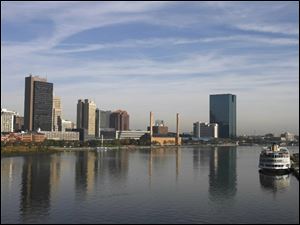
BROOKINGS INSTITUTION QUARTERLY STUDY
Metro Toledo ranking on recovery holds firm
9/19/2012
Metro Toledo's recovery from the recession ranked 16th, unchanged from last quarter, in the Brookings Institution Metropolitan Policy Program's second quarter Metro Monitor report.
Metro Toledo’s unemployment rate has fallen significantly since peaking at almost 13 percent in 2009, but a new report from a Washington think tank says the area’s employment growth hasn’t improved with the same strength.
Overall, metro Toledo’s recovery from recession ranked 16th — unchanged from last quarter — in the Brookings Institution Metropolitan Policy Program’s second quarter 2012 Metro Monitor report, which was released Tuesday. The monitor attempts to rank the recoveries of the 100 largest U.S. metropolitan areas by examining improvements in employment, unemployment, housing values, and output.
Brookings said metro Toledo had the fourth-best improvement in unemployment rate, and the 29th-best gains in gross metropolitan output, a gauge similar to gross domestic product. However, Brookings also said metro Toledo’s improvement in employment was 79th, and housing values dropped to a new low.
So why was the area rewarded with a 16th-best ranking?
“It’s more about where you’ve come from. It’s not so much where you are,” said Alec Friedhoff, a research analyst at Brookings and author of the report. “I think that’s one of the common misinterpretations. You can rank highly on this, but your economy can still be in a difficult state if you’re coming from a very deep recession.”
As for the discrepancy between unemployment rate and job growth, Brookings doesn’t really have an answer.
“We sit in a position to analyze the broad landscape, but a lot of the detailed questions to why aren’t available in the data we have,” Mr. Friedhoff said.
Brookings gets its data from Moody Analytics, which prepares its reports from data from the federal Bureau of Labor Statistics and Bureau of Economic Analysis.
The second-quarter unemployment rate in metro Toledo was 8.1 percent, down from 8.2 in the first quarter. It’s not possible to tell exactly why that rate has been dropping — some unemployed people found jobs, some may have moved away, others may have stopped actively looking for work and thus aren't counted as unemployed.
For job growth, Brookings doesn’t report actual employment figures, but rather a current percentage of peak employment. Although Brookings’ percentage shows a weaker performance in the year’s second quarter than in the first quarter, figures from Ohio’s Department of Job and Family Services show the area has gained jobs this year. A report on the Job and Family Services Web site shows that 5,800 more people in the metro area were employed in July than in January.
Still, no matter what data set or comparison is used, the Toledo metro area doesn’t have as many jobs as before the recession.
But Mike Veh, work force development manager at The Source of Northwest Ohio, Lucas County’s one-stop shop for unemployment services, said anecdotally it appears more employers are looking for new workers.
“What we’re seeing is an increases in the number of jobs through the doors. I would say it’s been increasing for a while,” he said. “It seems we’re seeing an increase in the number of midlevel jobs, the ones that have been so decimated through the recession.”
Those jobs don’t pay as well as they did, but Mr. Veh said the wages are getting closer. He also said officials are starting to see the beginnings of seasonal hiring.
On a national level, Mr. Friedhoff said Brookings sees a continuing but slow recovery with slowing output, a housing market yet to stabilize, and unemployment that’s still too high
“Were seeing a continuation of a long, difficult recovery,” he said.
In Ohio, Youngstown was highest ranked overall at 14th. Akron, Dayton, Columbus, and Cincinnati also were in the top 50. Cleveland was Ohio’s worst ranked, at 81st.
Contact Tyrel Linkhorn
at tlinkhorn@theblade.comor 419-724-6134.